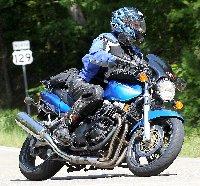Spindle encoder for lathe?
07 Apr 2021 14:23 - 07 Apr 2021 14:23 #205256
by Catch22
Spindle encoder for lathe? was created by Catch22
Hi everyone,
I have a homemade lathe and I would like to be able to thread with it, so I need to purchase an encoder for the spindle.
I have the mesa 5i25 with the 7i76 boards and looking for the easiest solution to ad the spindle encoder.
Any suggestions would be greatly appreciated.
Thanks Mike
I have a homemade lathe and I would like to be able to thread with it, so I need to purchase an encoder for the spindle.
I have the mesa 5i25 with the 7i76 boards and looking for the easiest solution to ad the spindle encoder.
Any suggestions would be greatly appreciated.
Thanks Mike
Last edit: 07 Apr 2021 14:23 by Catch22.
Please Log in or Create an account to join the conversation.
- robertspark
- Offline
- Platinum Member
-

Less
More
- Posts: 915
- Thank you received: 216
07 Apr 2021 19:20 #205280
by robertspark
Replied by robertspark on topic Spindle encoder for lathe?
depends upon what setup you have?
I added an encoder to my lathe, but given I was lucy to have a 40mm OD spindle, I obtained a 40mm hollow shaft encoder that just slipped onto the end of the shaft and provides a 1000ppr encoder.
I think it was this one (or very similar) + not that expensive.
ae01.alicdn.com/kf/HTB1teJxqrwTMeJjSszfq...l-Rotary-Encoder.jpg
I have seen others using remote toothed belt driven encoders
live.staticflickr.com/8353/8436224765_291a39bbb5_b.jpg
7xcnc.com/files/4613/5208/1361/NJW_2762.jpg
lots of ideas on the internet.
for an A&B signal (f you were to do it with optical sensors.... ) you need them ~ 90 degrees out of sync....
library.automationdirect.com/wp-content/...e-timing-diagram.jpg
for the MESA hardware because the synchronisation is done within the hardware you need to provide it with an INDEX pulse that MUST be 1 pulse per revolution. hence if you are belt driving it, you need to consider the pulley ratios..... it is possible to divide a frequency in standard numbers (2,3,4,5,etc) using a simple electronic circuit.... but its best to design it right from the start in my opinion as it will save you any synchronisation errors or problems (head scratching) later.
I am just a hobby user, and only have 1 device (lathe) using a high speed encoder, I am sure that there are users who do this regularly and have converted many machines and may have a different opinion.
I added an encoder to my lathe, but given I was lucy to have a 40mm OD spindle, I obtained a 40mm hollow shaft encoder that just slipped onto the end of the shaft and provides a 1000ppr encoder.
I think it was this one (or very similar) + not that expensive.
ae01.alicdn.com/kf/HTB1teJxqrwTMeJjSszfq...l-Rotary-Encoder.jpg
I have seen others using remote toothed belt driven encoders
live.staticflickr.com/8353/8436224765_291a39bbb5_b.jpg
7xcnc.com/files/4613/5208/1361/NJW_2762.jpg
lots of ideas on the internet.
for an A&B signal (f you were to do it with optical sensors.... ) you need them ~ 90 degrees out of sync....
library.automationdirect.com/wp-content/...e-timing-diagram.jpg
for the MESA hardware because the synchronisation is done within the hardware you need to provide it with an INDEX pulse that MUST be 1 pulse per revolution. hence if you are belt driving it, you need to consider the pulley ratios..... it is possible to divide a frequency in standard numbers (2,3,4,5,etc) using a simple electronic circuit.... but its best to design it right from the start in my opinion as it will save you any synchronisation errors or problems (head scratching) later.
I am just a hobby user, and only have 1 device (lathe) using a high speed encoder, I am sure that there are users who do this regularly and have converted many machines and may have a different opinion.
The following user(s) said Thank You: Catch22
Please Log in or Create an account to join the conversation.
07 Apr 2021 23:23 #205295
by JohnnyCNC
Replied by JohnnyCNC on topic Spindle encoder for lathe?
Attachments:
Please Log in or Create an account to join the conversation.
07 Apr 2021 23:24 #205297
by andypugh
You could consider a home-made encoder to match your lathe.
A disc with holes drilled in works well. Or slots with one deep slot for index.
Here is one I made: photos.app.goo.gl/KqzSrfFfCARS7DNs8
(That uses reflection sensors. That was a bad choice. Tramsmition slot sensors work a lot better)
You need 2 sensors for A and B, then a third for the index. A and B should be positioned such that when A is on an edge B is exactly between edges. It's best to have some adjustment available. A and B can be quite some distance apart as long as the phase relationship holds)
But a pair of equally-sized timing pulleys and an off-the-shelf encoder is probably easiest. The 7i76 supports differential encoders, so www.ebay.co.uk/itm/323526826533 would be ideal.
Replied by andypugh on topic Spindle encoder for lathe?
Hi everyone,
I have a homemade lathe and I would like to be able to thread with it, so I need to purchase an encoder for the spindle.
You could consider a home-made encoder to match your lathe.
A disc with holes drilled in works well. Or slots with one deep slot for index.
Here is one I made: photos.app.goo.gl/KqzSrfFfCARS7DNs8
(That uses reflection sensors. That was a bad choice. Tramsmition slot sensors work a lot better)
You need 2 sensors for A and B, then a third for the index. A and B should be positioned such that when A is on an edge B is exactly between edges. It's best to have some adjustment available. A and B can be quite some distance apart as long as the phase relationship holds)
But a pair of equally-sized timing pulleys and an off-the-shelf encoder is probably easiest. The 7i76 supports differential encoders, so www.ebay.co.uk/itm/323526826533 would be ideal.
The following user(s) said Thank You: Catch22
Please Log in or Create an account to join the conversation.
08 Apr 2021 14:13 #205323
by Catch22
Replied by Catch22 on topic Spindle encoder for lathe?
What would be better to go with the 5vdc or the 12 to 24vdc encoder, I thought I read somewhere that the 5vdc produces more noise.
Please Log in or Create an account to join the conversation.
- robertspark
- Offline
- Platinum Member
-

Less
More
- Posts: 915
- Thank you received: 216
08 Apr 2021 15:09 #205329
by robertspark
Replied by robertspark on topic Spindle encoder for lathe?
it depends / not really.....
I went with a 24V encoder BUT it only outputs 5V via a differential signal (so it's noise immune being differential, as noise would be induced into both signal lines (A+ & A- or B+&B- or I+ & I-) and will be removed when the signal is sensed.
I went with a 24V encoder because all of my controls circuits on lathe, plasma, mill, router run at 24V. The only 5V stuff I have is the step and direction signals (and they are differential too).
Otherwise I would have used a cheapo 24V >> 5V PCB anyway local to the device needing 5V.
Most electronics signals use low voltage (5v / 3.3V because of the high switching speed possible with less effect from slew rate (the effect from a signal rising / dropping quickly from a high (or relatively high) voltage to a lower voltage (basically making a square wave into a triangular wave such as that shown below).
Most high speed components are made for 5V or 3.3V these days or they use differential signals in my (little) experience (electronics is not my day job and has not been for +22 years).
www.electronics-notes.com/images/op-amp-slew-rate-effect-01.svg
I went with a 24V encoder BUT it only outputs 5V via a differential signal (so it's noise immune being differential, as noise would be induced into both signal lines (A+ & A- or B+&B- or I+ & I-) and will be removed when the signal is sensed.
I went with a 24V encoder because all of my controls circuits on lathe, plasma, mill, router run at 24V. The only 5V stuff I have is the step and direction signals (and they are differential too).
Otherwise I would have used a cheapo 24V >> 5V PCB anyway local to the device needing 5V.
Most electronics signals use low voltage (5v / 3.3V because of the high switching speed possible with less effect from slew rate (the effect from a signal rising / dropping quickly from a high (or relatively high) voltage to a lower voltage (basically making a square wave into a triangular wave such as that shown below).
Most high speed components are made for 5V or 3.3V these days or they use differential signals in my (little) experience (electronics is not my day job and has not been for +22 years).
www.electronics-notes.com/images/op-amp-slew-rate-effect-01.svg
Please Log in or Create an account to join the conversation.
- robertspark
- Offline
- Platinum Member
-

Less
More
- Posts: 915
- Thank you received: 216
08 Apr 2021 15:15 #205330
by robertspark
Replied by robertspark on topic Spindle encoder for lathe?
Also note: you mentioned using a 7i76..... the encoder will only accept a 5V signal, but it can be set up to recieve either a differential or single ended signal (i.e. A+ & A- etc or A+ and Zero Volt).
have a read of the manual and the jumper postions.
have a read of the manual and the jumper postions.
Please Log in or Create an account to join the conversation.
Time to create page: 0.226 seconds




